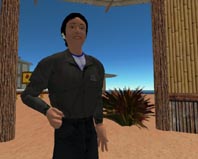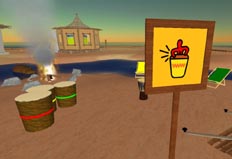I met with Ansi Orochi (a.k.a. Ansgar Schmidt, Lead Architect, Virtual Worlds, IBM Research and Development) on Sawubona on Second Life to ask him the question: “What Are The Most Important Characteristics of Web 3D?” Sawubona, is in a very early stage of development – the first official press release isn’t due for a month. But, it is already clear that this is going to be a ground breaking social music project in Second Life, combining global collaboration and technological innovation to raise money and awareness for a township project in South Africa.
An IBM mainframe has been harnessed to Second Life to allow Second Life residents to remix songs live in Second Life and even add their own voice. South African musicians have donated songs. And, musicians from all around the world and singers, drummers, guitar players and other musicians have contributed tracks that can be recombined in Second Life. The aim is for musicians from around the world to come to together to produce news songs. They will use the Sawubona to remix and collaborate to form virtual bands that will produce CDs and eventually go on a concert tour. The sale of these CDs and other spin off products will also go towards the township project, as will the proceeds from a stadium concert of Sawubona musicians during the 2010 World Soccer Cup, South Africa.
Many IBMers and T4-Media members have been donating time to this project. Jacqueline Wolff, Communications, IBM R & D Germany, responsible for Podcast and Videocast, is working with Ansi. She will produce a blog and podcast about the activities of Sawubona.
Sawubona felt like an auspicious place to discuss “the web as virtual world.” One of the characteristics of Web 3D, in my view, if it is to play a role in positive global development, is that it will emerge from such collaborations across community, culture and business.
Ansi is Eolus McMillan’s partner in the development of the EOLUS One initiative. EOLUS is pioneering, in Second Life, cross industry, academic and community collaboration to prototype large scale facility energy management, building planning, and retail 2.0 projects. EOLUS One aims to harness Second Life as a global creative context bringing communities and corporations together on designs that will benefit communities and the environment.
“The Web As A Virtual World.”
I began my discussion on Web 3D with Ansi by asking him some questions on a recent report in Business Week which, while acknowledging the place of the leaders on the road to Web 3D, Second Life, Google Earth and IBM, focuses on the first requirement of Web 3D – an agreement on open standards.
I was glad to see Business Week this week move on from reporting Second Life as though it was still 2005 (an era when Second Life was still seen as a game, see this earlier post) with this story, “Just Ahead: The Web As Virtual World:” And, BW finally gets to the crux of the matter, at least in topic selection:
Google (GOOG ), Second Life creator Linden Lab, IBM, and a bevy of additional companies are moving toward the day when you can stroll around a 3D Web–and not just their own sites–using a virtual replica of yourself that you’ve created. They are working to establish technical standards, open to all programmers, that would allow the entire Internet to become a galaxy of connected virtual worlds.
The BW report mentions that standards groups like the Web 3D consortium are meeting to develop open standards. And, in 18 months, “an interoperable avatar likely will be approved by the I.S.O., an organization that has verified technical standards like the JPEG, a shareable format for digital images, for its 157 member countries.” But the missing piece, in my view, is to link the discussion of open standards to an understanding of what the characteristics of virtual worlds will be most important when “technical standards, open to all programmers, that would allow the entire Internet to become a galaxy of connected virtual worlds.”
Cory again confirmed to BW that Linden Lab will open source the server code in a year or two so:
developers will be able to modify it to create their own Second Life-like sites and build connections so that a store or other application in one virtual site could interact with those in others
But, I was a little surprised by BW statement that Cory Ondrejka of Linden Lab had indicated:
The company has not decided whether it will hand the code to a standards body to oversee or will write it, get it working, and hope to set a de facto standard the way Microsoft Corp.’s (MSFT ) Windows trounced Apple Inc.’s (AAPL ) platform by opening up in the 1980s.
I hope to talk to Cory in depth about this soon as a “de Facto standard” does not seem in keeping with many other statements Cory has made re Linden Lab’s approach to making LL’s Second Life protocols available for the greater good.
Open standards are perhaps even more important to corporations than open sourcing the server code. And, Ansi was clear that while he is very impressed with what Linden Lab has done, and is doing, he thinks:
The world has learned and understood the value of open standards in contrast to proprietary approaches from some companies in the recent years. Creating de facto standards does not help anyone except the company creating them.
I will be doing a series of posts asking many people: “What Should Be The Characteristics of Web 3D.” Hopefully, there will many perspectives on this conversation from many quarters.
The mission of Ugotrade is to explore virtual realities role in creating a better planet. And, Second Life continues to provide more stories than I can keep up with in this regard. Philip Rosedale’s commitment to Second Life’s potential role in positive global development was clear to me back in April. And, Second Life continues to reveal new possibilities in this regard every time I log in.
Second Life – the most open and only truly user generated virtual world to date – already exhibits most of the characteristics that constitute a paradigm shift in global communications and knowledge production that can change the world completely much as Gutenberg’s invention of moveable type printing did, Ansi noted. He put it succinctly:
The main characteristics of the paradigm shift (to Web 3D) have already happened in Second Life.
Virtual Worlds are, in Ansi’s view, the Gutenberg 2.0 revolution. Gutenberg’s invention brought knowledge to the masses. But, virtual worlds and WEB 2.0 technologies can go a step further connecting us to each other in an immersive environment that is capable of transmitting whole cultures and reimagining communication in ways never possible before.
Wikipedia notes A&E Network ranked Gutenberg #1 on their “People of the Millennium” countdown, and in 1997, Time–Life magazine picked Gutenberg’s invention as the most important of the second millennium.[2
There seem to be a lot of interesting comparisons that could be made between Philip Linden and Gutenberg.
Gutenberg’s picture below (right) with picture of Philip Linden from Torley Linden’s Flickr stream (left) – “Philip Linden has many talents among them, typing while holding a flute :-)”
While it is still the infancy of Virtual World development, Linden Lab’s Second Life has in Ansi’s view laid down the ground work for on the chief characteristics of “the web as a virtual world.”
Web 3D should not only include increasingly sophisticated levels of avatar interaction (that will include level of body language communication not available yet), but new ways to handle digital rights so avatar’s can travel between virtual worlds.
One of the reasons Linden Lab has much work to do before open sourcing is to develop ways to protect, when the server code is open sourced, the hard work existing residents of Second Life have already put into the vast amount of assets they have developed in Second Life.
Second Life has a sophisticated and powerful micro-economy that currently includes the protection of intellectual property rights and the ability to easily share, give away or sell objects easily. Being able to handle digital rights for an interoperable avatar on Web 3D goes beyond the mere establishing of open standards but into the core characteristics that can make a vibrant virtual economy work. Linden Lab has uniquely created just such a vibrant virtual economy on Second Life. And, how this is integrated with open standards might well be the billion dollar question re the future characteristics of Web 3D.





August 15th, 2007 at 4:55 pm
Now that the value of true open standards has been “spread” by the pop articles of BW, maybe the new metarati will “join” the decade old web3d.org and pratice what they now realize they should be preaching. “ISO open standards” for a 3d connected web and internet.
Not one companies monopoly in mind share or access.:)
Alas its weds. and SL is down.
My 24/7 web 3d demo work is up and open at the http://www.mediaverse.net though….:)
Has anyone noticed that the “usage” and “desire” to use FLASH on every media website is decreasing? I wonder why? Food for Design professional thought.
cube3
August 24th, 2007 at 1:25 am
I was there a few days ago. I’ll be passing through over the next few weeks to gauge how it is doing once the buzz has worn off (it was completely dead the next day).
Time reveals all. I’ll write about it when time has had time to do its job.
August 24th, 2007 at 1:49 am
Dear Nobody
Sawubona has not launched yet. I explained that in the post and did not include a SLURL, so I am not sure what you expected to find!